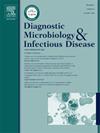Detection of bacterial pathogens directly from synovial fluids using digital PCR: A proof of concept study
IF 2.1
4区 医学
Q3 INFECTIOUS DISEASES
Diagnostic microbiology and infectious disease
Pub Date : 2025-02-15
DOI:10.1016/j.diagmicrobio.2025.116749
引用次数: 0
Abstract
Diagnosis of joint infections is often challenging due to low specimen volumes, low sensitivity of Gram stains and long incubation times of cultures. Digital PCR (dPCR) is a molecular tool that can detect nucleic acid targets with high sensitivity and resistance to inhibition. A 3 hour dPCR assay targeting the 16S gene was performed on archived synovial fluids. The assay detected the 16S gene directly from 4 µL of joint fluid without nucleic acid extraction. In 43 culture positive neat synovial fluids, the dPCR instrument detected 31 (72%) as positive, and 12 (28%) as indeterminate. In 49 culture negative specimens, dPCR was negative for 34 (69%), indeterminate for 14 (29%). The detection of bacteria was similar to real-time PCR performed on extracted specimens and demonstrated superior sensitivity to Gram stain. This technique shows potential as a rapid detection method for bacterial pathogens in synovial fluids, with optimization to improve specificity.
求助全文
约1分钟内获得全文
求助全文
来源期刊
CiteScore
5.30
自引率
3.40%
发文量
149
审稿时长
56 days
期刊介绍:
Diagnostic Microbiology and Infectious Disease keeps you informed of the latest developments in clinical microbiology and the diagnosis and treatment of infectious diseases. Packed with rigorously peer-reviewed articles and studies in bacteriology, immunology, immunoserology, infectious diseases, mycology, parasitology, and virology, the journal examines new procedures, unusual cases, controversial issues, and important new literature. Diagnostic Microbiology and Infectious Disease distinguished independent editorial board, consisting of experts from many medical specialties, ensures you extensive and authoritative coverage.

 求助内容:
求助内容: 应助结果提醒方式:
应助结果提醒方式:


